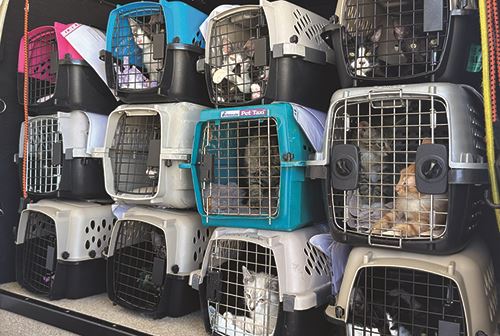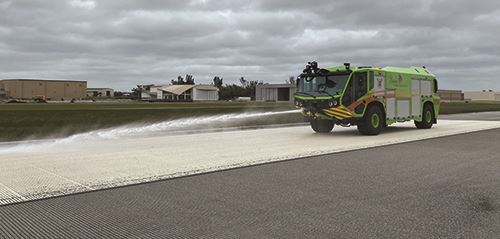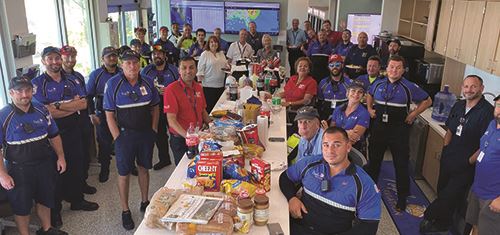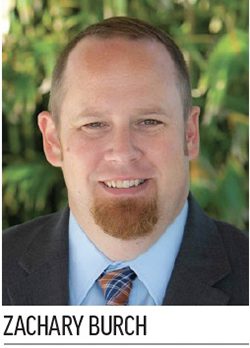Hurricane Ian’s storm surge caused flooding from the Gulf of Mexico and the Gordon River, which runs along the west side of Naples Airport (APF). The storm surge pushed saltwater up from the Gulf and into the airport.
Last September, Category 4 Hurricane Ian entered the Gulf of Mexico at high tide and lingered over Naples, FL, for the better part of a day. Unlike when Hurricane Irma hit the area five years earlier, this time there was minimal wind damage. But the storm surge caused flooding from the Gulf of Mexico and the Gordon River, which runs along the west side of Naples Airport (APF) and connects Naples Bay and the Gulf of Mexico. The storm surge pushed saltwater up from the Gulf and into the airport—filling the airfield to a depth of 2 to 4 feet in just 15 minutes. A U.S. Customs camera captured footage of whitecap waves obscuring all but the very tops of airfield signs.
When Zachary Burch, Community Engagement/Communications manager for Naples Airport Authority, came into work at 6:00 the next morning, there was still a lot of standing water. Thanks to recent drainage system improvements designed and permitted by EG Solutions, the higher east end of the airfield had dried out more quickly than other areas.
|
facts&figures Project: Storm Recovery Location: Naples (FL) Airport Airport Owner: Naples Airport Authority Storm: Hurricane Ian Date: Sept. 28, 2022 Damage: All airfield lights & signs (approx. 1,200); NAVAIDS Impact to Flight Operations: Emergency helicopter operations remained open; other daytime operations resumed in 2 days; nighttime operations were suspended for 14 days Recovery Timeline: Temporary repairs made within first 2 weeks; full replacement of airfield lighting & NAVAID systems (due to corrosion) expected in 2-3 years Repair Costs: $10 million-$12 million Funding Sources: Insurance; airport; possibly FEMA Immediate Damage Assessment: Hanson Professional Services Assistance & Supplies to Restore Airfield Lighting: Greater Orlando Airport Authority; Lake Charles Regional Airport; Martin County Airport; Port Authority of New York & New Jersey; Savannah/Hilton Head Int’l Airport; Southwest Florida Int’l Airport; Southeast Airports Disaster Operations Group Associated Recovery Projects: Replacing electrical vault; building door replacements; replacing/raising gate motors above ground level Ongoing Evaluation for Long-term Repairs: Hanson Professional Services Design of Replacement Airfield Lighting System: AVCON Inc. Design & Permitting for Previous Drainage System Improvements: EG Solutions |
The Immediate Aftermath
With most of the briny floodwater gone, logs, debris and fish littered the airfield.
Even though some employees had lost everything in the storm, they rolled up their sleeves to clear the runways, taxiways and apron so APF could reopen for passengers.
“The whole team came together,” remarks Barry Brown, director of Operations and Maintenance. “We set up our own version of an EOC [emergency operations center] and met for 20 or 30 minutes to get our game plan together, then went out and tackled everything. I can’t even tell you how many truckloads of debris we took off the runways and taxiways. It was amazing.”
Burch describes the response as inspiring: “Despite many employees having damage or completely losing their homes or vehicles, everyone just showed up—everybody from maintenance and cleaning staff to our FBO and our administrative staff, plus people like me who type for a living.”
Using the airport’s two 1,500-gallon fire trucks to wash down pavement and other surfaces with fresh water was a complete game-changer, he adds.
Thanks to the tireless efforts of employees, APF was able to reopen for emergency helicopter landings by noon that day and for daytime rescue flight operations the following day. Resuming critical operations was crucial because APF serves as a hub for first responders—not just the fire station and sheriff’s department based on the airfield who needed access to planes and helicopters for search and rescue efforts, but also for local first responders, tree trimming crews and other crews from the across the U.S. who came to help. Essentially, APF was the only way to get resources in or out because the area’s main commercial airport, Southwest Florida International Airport (RSW) in Fort Myers, and nearby Punta Gorda Airport (PGD) both remained closed.
Another aspect of rescue efforts was dealing with pets on the loose after homes and fences were destroyed. Once again, APF figured prominently because the Humane Society, one of its tenants, was the only animal shelter open in five surrounding counties. Airport Authority staff helped the Humane Society evacuate more than 1,000 cats and dogs to no-kill shelters in other states.
Employees also worked with community organizations to collect and deliver 18 pallets of supplies to Pine Island, a barrier island that was cut off from the mainland when Hurricane Ian destroyed the connecting bridge.
Assessing the Damage
It quickly became apparent that the airport’s biggest problem was going to be unreliable or completely inoperable airfield lighting and other electrical components such as signs and NAVAIDS, due to lingering effects of the storm surge.
 “Across the airfield, basically anything that saltwater touches begins to corrode immediately,” Brown explains. “Any electronics that it gets into are pretty much doomed to failure.” In their initial assessment, airfield maintenance crews found that all the runway end identifier lights were out, and only one set of precision approach path indicators (PAPIs) was functioning. In addition, about 200 taxiway edge lights were flickering or not working at all.
“Across the airfield, basically anything that saltwater touches begins to corrode immediately,” Brown explains. “Any electronics that it gets into are pretty much doomed to failure.” In their initial assessment, airfield maintenance crews found that all the runway end identifier lights were out, and only one set of precision approach path indicators (PAPIs) was functioning. In addition, about 200 taxiway edge lights were flickering or not working at all.
The Airport Authority promptly reached out to Hanson Professional Services Inc., its on-call airport engineering consultant for more than a decade. The firm had specific experience to draw on, as it provided assessment and recovery support at APF after Hurricane Irma in September 2017. Mike Harris, an aviation project manager for Hanson at the time, was a key part of the post-Ian effort. (These days, he works for EG Solutions.)
Harris and Brown immediately reached out to other airports that had weathered similar damage, including Lake Charles Regional (LCH) in Louisiana, which has suffered multiple bouts of hurricane-related flooding. The Port Authority of New York and New Jersey shared tips about how its airports recovered after Hurricane Sandy in 2012.

Airport workers helped the Humane Society evacuate cats and dogs to no-kill shelters in other states
The team at APF also received help from the Southeast Airports Disaster Operations Group (SEADOG), an informal collection of airports in about 20 southeastern states that support each other in times of crisis. SEADOG members assisted with tips on facilitating the flow of assistance from the state, and also supplied moral support and resources—including a mood-boosting delivery of food from Chick-fil-A. Martin County Airport (SUA) and RSW sent electrical staff to help out.
 Harris and his team conducted an evaluation and damage assessment, and created a report that documented conditions for insurance and FEMA purposes. The assessment detailed the various states of damage to APF’s runway and taxiway lights, NAVAIDS and other vital components that prevented the airport from accommodating nighttime or low-visibility traffic.
Harris and his team conducted an evaluation and damage assessment, and created a report that documented conditions for insurance and FEMA purposes. The assessment detailed the various states of damage to APF’s runway and taxiway lights, NAVAIDS and other vital components that prevented the airport from accommodating nighttime or low-visibility traffic.
Brown and Harris worked with ADB SAFEGATE to obtain new airfield lighting. Despite typically long lead times, the company was able to prioritize APF’s needs and provide replacement taxiway edge lights within two days.
Orlando International Airport (MCO) also provided 300 taxiway edge lights it had salvaged from a recent construction project.
Maintenance crews spent approximately two weeks replacing the lights and isolation transformers, and reconnecting the system to get it back up and operational. They were also able to revive about 30 LED airfield signs that had been underwater. Direct wiring the signs got them working in the short-term, but the airport knew they would have a very limited lifespan due to the corrosive nature of saltwater.
When initial cleanup was complete and lighting was functional—at least temporarily—the team from Hanson moved on to a full evaluation of buildings that had been flooded. Most were older T-hangars in the lower-elevation south quadrant of the airport. Flooding of 6 to 18 inches affected the airport’s pilot lounge, Facilities building, flight schools, sheriff’s department and a Civil Air Patrol hangar. Hanson personnel assessed drywall damage, made sure all hangar doors were operational and the electrical system was properly functioning. Naples Airport Authority then directed drywall removal and mold remediation as needed. There was also major damage to ground service equipment and one of the airport’s fuel trucks.
The assessment and documentation by Hanson helped inform the firm’s recommendations for rebuilding.

Recommendations for Recovery
With short-term fixes underway, nighttime operations resumed about two weeks after the storm. Harris and his team then focused on more permanent recovery of the airfield lighting. Based on discussions with the Port Authority of New York and New Jersey, the firm recommended a full replacement of the airfield electrical system. “The Port Authority shared with us that the biggest concern was about additional corrosion over time,” Harris explains. “You have electrical cables, metal lighting fixtures, transformers, metal light base cans and all the grounding. Even though the lighting was brought back up as an emergency repair, components were likely to start failing, left and right, over time.”
 The Hanson team worked with Ken Warriner, senior director of Finance for Naples Airport Authority, on cost estimates and potential recovery scenarios to replace airfield lighting, signage, light bases, cable/conduit and NAVAIDS. “We knew with all the saltwater inundation, it wasn’t going to be reliable over time,” Harris says.
The Hanson team worked with Ken Warriner, senior director of Finance for Naples Airport Authority, on cost estimates and potential recovery scenarios to replace airfield lighting, signage, light bases, cable/conduit and NAVAIDS. “We knew with all the saltwater inundation, it wasn’t going to be reliable over time,” Harris says.
The estimated cost to replace the entire system is $9 to $10 million.
Warriner was pleased with the insurance company’s response the day after the storm. “They helped us out immediately with resources and being able to get back in business and from a financial standpoint,” he recalls. “We’ve been working with the claims adjusters and with FEMA as a backup to insurance.
“It’s a pretty huge project and there are a lot of steps we’ll have to go through with the procurement process,” he adds. As of mid-August, APF had received about $4.2 million to cover repairs.
Recommendations for the new lighting included corrosion-resistant materials, primarily stainless steel base cans and a grounding system, to protect the system in the event of another saltwater storm surge. Hanson consultants also explored better ways to waterproof the underground airfield lighting connections. In addition to waterproof molded plugs, project engineers recommended a heat shrink or cold shrink kit to provide another layer of waterproofing for the connections.
“We talked to a lot of different lighting manufacturers about what the potential longevity of the system would be and what the issues would be,” Harris relates. “With the saltwater intrusion, one thing they suggested for the replacement project was setting the system up in a way that allows it to be flushed with fresh water to rinse off all the salt residue and prevent additional corrosion after the fact.”
Unfortunately, flushing APF’s existing system wasn’t possible because of how it was originally installed.
Longer-term considerations include raising the runway and taxiway pavements 1 to 2 feet, replacing low-elevation buildings, redeveloping the East Quad/South Ramp areas and other projects with an estimated total cost of $50 to $70 million.
The Airport Authority selected AVCON, Inc. to design the replacement airfield lighting system. Once the project design and engineering is complete, it will solicit bids for construction.
Moving on and Paying It Forward
With time still remaining in the 2023 hurricane season, preparations are being made for the next potential storm.

The Airport Authority is establishing a more formal emergency operation center in APF’s aircraft rescue and firefighting building, and has also significantly increased its inventory of lights and sign parts. “We still have lights that burn out more frequently,” Brown reports. “It’s really dwindled now, but especially in the six months following the storm, we had fixtures going out all the time. We doubled our stock so that if anything were to happen, we’ll be able to cover it.”
 Staff at APF deeply appreciated the help they received from other airports after Hurricane Ian, and have reciprocated whenever possible. One chance came in March 2023, when Fort Lauderdale-Hollywood International Airport (FLL) got 25 inches of rain in four hours during a freak storm. Unsurprisingly, FLL experienced airfield issues; and APF leaders were among the first to offer help. Ultimately, they provided 50 taxiway edge lights to help FLL quickly return to operational status. “We wanted to make sure we were available because we’ve been the beneficiary of so many other airports and organizations that helped us out after the storm,” says Burch. “We’re paying it back and paying it forward whenever we can.”
Staff at APF deeply appreciated the help they received from other airports after Hurricane Ian, and have reciprocated whenever possible. One chance came in March 2023, when Fort Lauderdale-Hollywood International Airport (FLL) got 25 inches of rain in four hours during a freak storm. Unsurprisingly, FLL experienced airfield issues; and APF leaders were among the first to offer help. Ultimately, they provided 50 taxiway edge lights to help FLL quickly return to operational status. “We wanted to make sure we were available because we’ve been the beneficiary of so many other airports and organizations that helped us out after the storm,” says Burch. “We’re paying it back and paying it forward whenever we can.”
“The amount of support other airports gave us during that time was fantastic,” Brown agrees. “Any chance that we get to pay it forward, we do.”



